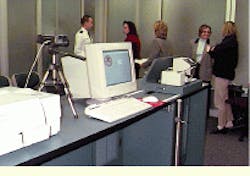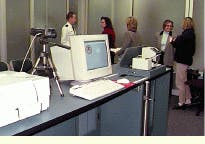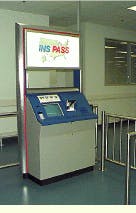Imaging system and biometric data identify airline travelers
Imaging system and biometric data identify airline travelers
Integrated with numerous components, an imaging automated inspection system helps US government agencies screen international airline travelers for lawful entry.
By R. Winn Hardin, Contributing Editor
To screen international airline travelers and immigrants for lawful entry, the United States Immigration and Naturalization Service (INS), with support from other government agencies, has developed and installed an automated imaging inspection system, INS PASS (Passenger Accelerated Service System), at US international
airport terminals. These systems validate biographical and biometric data and digital images against a computer-stored database to correctly identify several hundred thousand travelers and tourists.
The INS received a 1996 Federal Technology Leadership Award for the INS PASS system. Moreover, system operation and results have been so successful since its inception that Canada and Israel have begun designing their own automated inspection systems using the US system as a model.
Creating records
International travelers leaving and entering the United States are being encouraged to enroll in the INS PASS system as a means of corroborating their identity and to prevent the unlawful departure and arrival of criminals, terrorists, and illegal immigrants. In the enrollment procedure, the INS PASS establishes a person`s identity by first collecting his or her biographical data, a digital photograph, and a biometric hand template. The data are then stored on a keycard and in the US Customs Service database in Newington, VA, via the system`s mainframe computer (see Fig. 1). During this enrollment step, a trained INS agent meets the person and asks questions identical to those used to certify a US passport.
The INS PASS Global Enrollment System incorporates a P54C mid-tower computer with a 133-MHz Pentium processor from Polywell Computers (San Francisco, CA). Attached to the computer are several peripheral devices, including an optical-character-recognition (OCR) card reader from Imaging Automation (Merrimack, NH), a digital fingerprint reader from Recognition Systems (San Jose, CA), a camera from Eastman Kodak (Rochester, NY), a plastic card printer from DataCard Corp. (Bethesda, MD), and an ID3DR HandKey fingerprint scanner from Identix (Herndon, VA; see Fig. 2).
After collecting the standard biographical data, the person`s fingerprints are collected digitally with a Touch View II Model TV-555 scanner from Identix. This miniature scanner illuminates a person`s fingers with infrared (IR) light and captures the resulting image with a built-in charge-coupled-device (CCD) sensor. The resulting NTSC image is then sent over a serial video cable to a Comet board from Matrox Electronic Systems (Dorval, Quebec, Canada) inside the computer. In turn, the computer compresses the image using the wavelet scalar quantization (WSQ) method, an FBI image-compression standard.
According to Russ Kent, senior systems engineer at Electronic Data Systems (EDS; Plano, TX) and a systems integrator for the INS PASS system, the WSQ method loses less data during the compression process. In addition, the WSQ method does not interject blocky artifacts during the compression process as do some standard photograph-compression techniques, such as JPEG.
Although the Identix fingerprint reader can be used as a biometric `key` by comparing a scanned template (an algorithm composed of a mathematical representation of unique physical traits) with a stored template, the INS PASS system currently does not use fingerprints as a key. Fingerprints are collected, however, because in the future they will be used as an additional identity check or for other services offered by the INS PASS system.
This system also takes the person`s picture using a Kodak DC 50 or 120 digital camera with a serial port output. The camera is controlled by software resident on the computer. The serial cable plugs into a PC/8e eight-port serial board from Digi Corp. (Minneapolis, MN). These multiple connections accommodate the existing number of peripherals, as well as expected future enhancements.
"We went to a multiport board instead of just using the PC`s ports because of driver and interrupt conflicts. If a device will run on the third, fourth, or fifth communications ports, you might as well connect it to a multiport board because when you need Com-1 or Com-2 for specific devices you`ll have them available," says Russ Kent.
During a final identification step, the INS agent gathers a template of the person`s hand using an ID3DR HandKey-based hand-geometry biometric system from Recognition Systems (Campbell, CA). This system uses a near-infrared light-emitting diode (LED) with a peak emission around 880 nm to illuminate the hand (see Fig. 3). A TC211 32-Kpixel CCD sensor from Texas Instruments (Dallas, TX) simultaneously collects an 8-bit monochrome image of the hand from below and from the side using an integrated mirror assembly.
The analog sensor image is digitized by an A/D converter and is then fed into a Z180 micropro cessor, where a proprietary algorithm determines the unique characteristics of the hand, according to Bill Spence, pres ident of Re cog nition Systems. During the test, the HandKey registers are queried in command mode by the custom software. Developed by EDS, the software constructs an image representation on the computer screen with red and green lights. This reader representation illustrates the position of the person`s hand and fingers and provides the INS agent with feedback to indicate when the hand is in proper position. Once the HandKey verifies correct positioning, the actual template is constructed.
As many as 200 bytes of proprietary resident code determines the hand`s outline by measuring changes in pixel-to-pixel intensity. This code then performs a blob analysis to measure the relationships for 96 points on the hand, such as how the area of the knuckle compares with the width and length of a particular finger. Once the unique characteristics are determined, the hand unit transmits a 9-byte template to a signal converter from Black Box (Pittsburgh, PA) that converts the RS-422 signal, the HandKey`s output, to an RS-232 serial signal.
The 9-byte template then passes through the multiport serial board into the computer. Here, it is saved in temporary memory for later transmission to the US Custom Service`s mainframe computer (during the enrollment process) or for verification at the system computer during an automated kiosk inspection.
After collecting biographical data, fingerprints, a digital picture, and a hand template, the system computer sends all the information via an Etherlink card from 3-COM (Salt Lake City, UT) to the INS local gateway and then to the Custom Service mainframe computer in Newington, VA, via a secure wide-area network. At the mainframe, the information is used to query relevant government agencies, including law-enforcement agencies. Assuming the person does not have a background that would preclude normal acceptance, the system completes the process by printing out a plastic identification card.
To print the card, the INS uses the DataCard Imagecard 3-plus printer with duplex and magnetic-strip encoding options from DataCard Corp. (Bethesda, MD). Connected to the computer`s parallel port via an IEEE-1284 compatible cable, the printer prints the biographical data and the person`s picture on one side of the card and three lines of OCR-B (a machine-readable fixed-font) code on the other card side in a format compatible with the International Civil Aviation Organization, the international standard used for passport encoding. It also encodes the magnetic stripe on the back of the card with the person`s INS PASS identification number, name, and card expiration date.
The duplex option allows printing on both sides of the card without the INS agent having to manually remove, flip, and re-insert the card. After enrollment, this card and the person`s hand are the only keys needed to clear the automated inspection process and pass through Customs. However, the INS PASS card is not considered a passport.
Catching a plane
Unlike the enrollment stations, automated INS PASS kiosks are unmanned but monitored. Therefore, a more intricate inspection system is needed that uses several levels of checks and double checks to prevent unlawful persons from passing through the inspection process (see Fig. 4).
Within the kiosk, the INS uses a Polywell computer with 32 Mbytes of memory as the system host running on Microsoft Windows 3.11. Although this system will soon be upgraded to a Windows-NT environment, fast clock speeds are not crucial to the current application. Kent explains that the Windows-NT upgrade and other planned architectural changes will allow the computer to more quickly generate reports on usage, the number of persons accepted and rejected, and the source of any processing error.
The traveler or tourist accesses the INS PASS kiosk through an Imaging Automation (Merrimack, NH) EyeRead 2000 OCR-B card reader and a touch screen. The card reader uses a CCD sensor to image the person`s card and a proprietary frame grabber to perform optical character recognition on the OCR-B character string imprinted on the back of the card. This data-string query is sent to the US Custom Service`s mainframe via the local INS local-area network and gateway. In response, the hand template is sent back to the kiosk computer for comparison with the person`s hand.
Next, the person enters the departure or arrival airline flight information on the touch screen from Reflex International (Norcross, GA), which uses Microtouch Cleartek 2000 technology. The touch-screen monitor plugs into a Matrox Millennium video board, and the touch screen controller is plugged into a computer`s serial port. Flight information entered through the touch screen is checked against the passenger manifest received via the local LAN accessed by the Etherlink board. If the person has arrived on a flight that provides passenger information to APIS (Automated Passenger Information System), the person can skip the entry of this information on the touch screen as the kiosk receives this information automatically through its local INS LAN connection. The computer now knows from the card who the person is supposed to be
For corroborating evidence, the person positions a hand onto the ID3DR HandKey device. This device generates a new template and passes it though the signal converter for changing RS-422 signals to RS-232 signals to a serial port on the multiport board. The converter also provides optical isolation between the PC and the HandKey in the event of a power surge or other potentially crippling signal. Comparing the hand geometry templates takes place within the computer; however the HandKey is also capable of performing the comparison, according to Recognition Systems` Bill Spence.
Because each template, just as each person`s hand, is unique, the new template must match the stored template. If it does not, or there is any reason for rejection, such as an expired card, the passenger is referred by the system screen to an INS agent in a nearby Inspections booth. The PC also sends, via the Immigration and Naturalization Service local-area network, an "alert" message to the agent, giving the reason for the referral via a printout on a 4 ¥ 12-in. 5300 impact printer from Star Micronics (Middleton, MD).
In addition to logging the problem and alerting the agent, the printer emits a buzzer alarm signal. Although the problem could be as simple as a disconnection, "the most important reason for this printer alarm is safety, to alert the agent of the possible presence of an unlawful person," explains Kent.
FIGURE 1. During the enrollee process, the US Immigration and Naturalization Service agent collects digital fingerprints, portraits, and hand geometry. The information is then sent to a central database computer at the US Customs Service for storage.
FIGURE 2. The INS PASS Global Enrollment System (GES) incorporates a P54C mid-tower computer with a 133-MHz Pentium processor. Attached to the computer are several peripheral devices, including an optical-character-recognition (OCR) card reader, a digital fingerprint reader, a CCD camera, a plastic card printer, and an ID3DR HandKey biometric system.
FIGURE 3. The Recognition System ID3DR HandKey system creates a 9-byte template of a person`s hand based on 96 measurements. A near-infrared light-emitting diode with a peak emission around 880 nm illuminates the hand. A TC211 32-Kpixel CCD sensor simultaneously collects an 8-bit monochrome image of the hand from below and from the side using an integrated mirror assembly. A proprietary algorithm determines the unique characteristics of the hand.
FIGURE 4. Automated INS PASS kiosks are being deployed in international airports for protection against illegal entry (right). The person accesses the INS PASS kiosk through an EyeRead 2000 OCR-B card reader and a touch screen (left). The card reader uses a CCD sensor to image the person`s card and a proprietary frame grabber to perform optical character recognition on the OCR-B character string imprinted on the back of the card. This data string query is sent to the US Custom Service`s mainframe via the local INS local-area network and gateway. In response, the hand template is sent back to the computer for comparison with the person`s hand.





